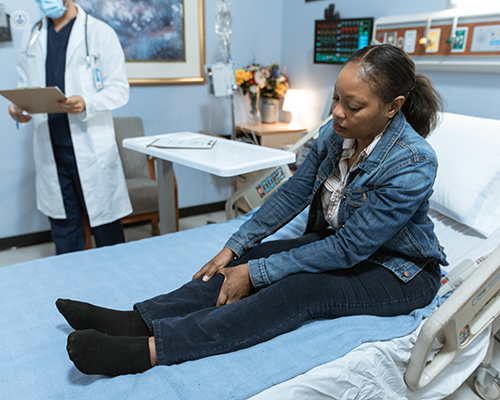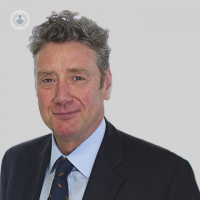An expert on ankle arthroscopy
Written by:Ankle arthroscopy is a minimally invasive technique used by surgeons to treat problems of the ankle joint. In our most recent online interview, esteemed orthopaedic surgeon Mr Simon Moyes explains further what it is and what it is used to treat. The London-based consultant orthopaedic and sports medicine surgeon, details which conditions this treatment is suitable for, potential risks and side effects, and how soon afterward the patient can walk.

What is ankle arthroscopy and what does it treat?
Ankle arthroscopy, keyhole surgery of the ankle, has been around since the early 90s. I was one of the pioneers of it when I first started doing it in ‘94. It treats arthritic change, bone spurs, cartilage damage, loose bodies, inflammatory problems, and instability. It can also be used to help treat bad injuries to the ankle such as nasty fractures, collections of blood in the joint, or even infections.
What can a patient expect in preparation for the procedure?
Almost all ankle arthroscopies are routine, elected procedures. Very little preparation is required, other than what is necessary for standard knee arthroscopy. Patients have to have a light general anaesthetic so they have to fast for a few hours prior to the procedure. The surgeon will also explain to the patient in detail what type of procedure they’re having done.
For a simple surgery to remove scar tissue, bone spurs, or inflammatory issue, the patient would be told how long the procedure would take, how painful it might be afterward, whether they're going to be fully weight-bearing or partially weight-bearing, and whether they’ll need a supportive bandage or other appliances. In the case of ligament reconstruction surgery, they’d be advised that they’re going to be weight-bearing in an air cast boot. The only preparation they really need is advice from their surgeon as to what to expect from the surgery and post-operative rehabilitation are going to involve.
What are the risks and side effects of ankle arthroscopy?
Fortunately, there are very few risks and side effects. Like with any procedure, there is a risk of infection, but for ankle arthroscopy, we count that risk as being less than 1%. I have never had a serious infection from arthroscopy alone, so the chance of it occurring is probably around 1 in a thousand. There is also a risk of irritating a nerve on the outside of the ankle, also deemed to be less than 1%. When patients get this nerve irritated by the cameras, they get pins and needles (paraesthesia) on the top of their feet. Occasionally it is permanent, but normally it just lasts for a few weeks. There are other risks like deep vein thrombosis that would be present with any operation, but again that risk is less than 1%.
What is recovery like? How long until a patient can walk afterward?
Ankle arthroscopy alone, without any other interventions, it’s a day procedure and the patient can walk out of the hospital fully weight-bearing after the surgery. Patients that also have microfracture surgery for full-thickness cartridge defects will normally require a supportive bandage in addition and the majority are fully weight-bearing. Patients that have had microfracture surgery for a defect would be non-weight-bearing for up to four to six weeks while those who’ve had ligament reconstruction surgery as well would be in an air cast boot for three-week but they can fully weight bear in that situation. Recovery really depends on what type of ankle arthroscopy surgery you’re having. You should always ask your surgeon what would the recovery process be, and what would recovery look like for that particular procedure.
What is the success rate?
Generally, the success rate for an ankle arthroscopy is high, but it depends on what you’re having done. If you’re having ankle arthroscopy and ligament repair, success rates for that would be 95%. If you’re having a bone spur removed or a footballer’s ankle treated, there’s an 85-90% likelihood of good or excellent results. If you’re having inflammatory tissue or menisci bands treated, the success rate is in the 90% range. If you’re trying to treat arthritis of the ankle joint, then it depends a bit on how bad the arthritis is in the individual's ankle. If you’re having microfracture surgery for a cartilage defect then success rates are probably 80-85%.
If you are interested in booking a consultation with Mr Simon Moyes you can do so directly from his Top Doctors profile.


